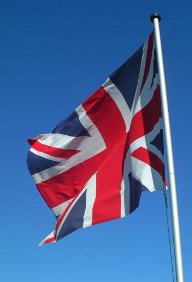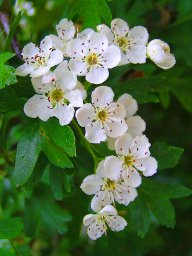Wednesday 1 April 2009
Music by Samuel A. Ward

This melody comes from the hymn “Materna” by American organist and composer Samuel A. Ward, who actually never met the author of the words of “America the Beautiful”, Katharine Lee Bates.
At various times in the more than 100 years that have elapsed since the song as we know it was born, particularly during the John F. Kennedy administration, there have been efforts to give “America the Beautiful” legal status either as a national hymn, or as a national anthem equal to, or in place of, “The Star-Spangled Banner”, but so far this has not succeeded. Proponents prefer “America the Beautiful” for various reasons, saying it is easier to sing, more melodic, and more adaptable to new orchestrations while still remaining as easily recognizable as “The Star-Spangled Banner”. Some prefer “America the Beautiful” over “The Star-Spangled Banner” due to the latter's war-oriented imagery. (Others prefer “The Star-Spangled Banner” for the same reason.) Anyway, “America the Beautiful” continues to be held in high esteem by a large number of Americans.
Thursday 2 April 2009
by Joseph E. Winner
Although this song is now popularly taught to children as an old American folk song, it was originally intended as a drinking song. The original lyrics tell a story about a man and his wife who are very good-humored alcoholics.
The verses are basically a love song to alcohol, talking about how this man and his wife will never give up the sauce as long as they live.
Ha, ha, ha, you and me,
Little brown jug, don't I love thee!
Ha, ha, ha, you and me,
Little brown jug, don't I love thee!
Although the song was written in 1869, it enjoyed new popularity during prohibition when people were sneaking illegal alcohol. Several big band versions were recorded, bringing the old folk song further into the mainstream.
Friday 3 April 2009
by Michael Praetorius
A “Volta” is a lively Renaissance dance for couples, a known favorite of Queen Elizabeth the first, who loved to dance to it. It is really more a type of piece than a specific piece, but this one by Praetorius is probably the most famous of them all.
A virtuoso organist, an organ builder, a composer and an assiduous musical scholar, Praetorius is celebrated for writing a remarkable three volume musical treatise, the Syntagma musicum, which allows us rare and fascinating glimpses into the musical sensibilities of his time.
He was for his time a man of tremendous erudition, a polymath who was well versed in philosophy, theology and languages (including Latin, Greek and Hebrew) in addition to his formidable theoretical and practical understanding of music.
Praetorius was also one of the most prolific composers of his generation in Germany, listing over forty volumes of printed music at the end of the Syntagma musicum, including sacred and secular works of all kinds.
Saturday 4 April 2009
E-I-E-I-O!

This is not only a simple tune that even beginners can enjoy playing. It may also be thought as an exercise to enhance the quality of your sound in the first register. And, why not, in the second and third registers, too. The range of this song is small enough to allow direct transposition even to the high register, peaking at high B.
Will you be able to sound better than the MP3 recording? I'm sure you can. You just have to use good articulation and a bit of expression. As there are no technical difficulties, try to focus on the truly essential elements of flute playing, such as breathing and articulation. Forget your fingers (so to speak): when you manage to master your tongue and to develop a clear articulation, the most difficult part of the work will be done!
Sunday 5 April 2009
by Gottfried Heinrich Stölzel
This piece is often mistakenly attributed to Johann Sebastian Bach due to its inclusion in the famous Notebook for Anna Magdalena, but the aria was actually part of the Stölzel opera Diomedes oder die triumphierende Unschuld (1718), whose score is now lost.
With its infinitely sweet melody, “Bist du bei mir” has recently become a very popular choice for wedding ceremonies and other such occasions.
Monday 6 April 2009
Join in the celebrations of Tartan Day 2009
On the occasion of Tartan Day, we are posting one of the most popular Scottish songs, frequently used at special occasions and sporting events.
Although Scotland has no official national anthem, “Flower of Scotland” is one of a number of songs which unofficially fulfill this role, along with “Highland Cathedral” and the older “Scotland the Brave”. It was written by Roy Williamson of the folk group The Corries, and presented in 1967.
If you don't know how this tune, you might get a little confused by its rhythm at first. Don't worry: as always, you can easily get a grasp of it by listening to our audio files.
Tuesday 7 April 2009
aka “The Ants Go Marching One By One”
This song is generally credited to the Union Army bandmaster Patrick S. Gilmore, who published it in 1863 under the pseudonym ‛Louis Lambert’. It is similar to the Irish antiwar song “Johnny I Hardly Knew Ye”, which is presumed to be the original on the basis of oral evidence, although no published version is known to pre-date “When Johnny Comes Marching Home”.
This tune has been used in the soundtracks of several movies, including Gone with the Wind, Kubrick's Dr. Strangelove or: How I Learned to Stop Worrying and Love the Bomb and Die Hard With a Vengeance. It was also used in some episodes of The Simpsons.
You may also know this song for its use as a nursery rhyme, as it's the tune of “The Ants Go Marching One By One” (Hurrah! Hurrah!) and “The Animals go in Two by Two”.
Wednesday 8 April 2009
North East English folk song
Bobby Shafto's gone to sea,
Silver buckles on his knee;
He'll come back and marry me,
Bonny Bobby Shafto!
Bobby Shafto's bright and fair,
Panning out his yellow hair;
He's my love for evermair,
Bonny Bobby Shafto!
Robert Shafto (sometimes spelt “Shaftoe”), an 18th Century British Member of Parliament, appears to be the likeliest subject of this famous nursery rhyme. The song is said to relate the story of how he broke the heart of Bridget Belasyse of Brancepeth Castle, County Durham, when he married Anne Duncombe of Duncombe Park in Yorkshire.
Thursday 9 April 2009
Traditionally attributed to Johann Sebastian Bach
This famous piece was traditionally attributed to Johann Sebastian Bach, as it appears in the Notebook for Anna Magdalena, a notebook which Bach offered to his wife Anna Magdalena in 1725 and which was to be filled with favorite selections of the members of the Bach family.
However, recent research has concluded that this minuet (sometimes referred to as “BWV Anhang 114”) was probably composed by Christian Petzold, a German composer and organist contemporary with Bach.
As you will see, the score contains some suggestions for realizing ornaments in accordance with Baroque performance practice; when first learning the piece, you should ignore them.
Friday 10 April 2009
aka “Ah! vous dirai-je, Maman”
Among the most popular English nursery rhymes, “Twinkle Twinkle” combines the tune of the 1761 French melody “Ah! Vous dirai-je, Maman” (“Ah! I shall tell you, mum”) with an English poem, “The Star” by Jane Taylor. Many other songs in various languages have been based on the same melody, notably the “Alphabet Song” and “Baa, Baa, Black Sheep”.
Many think that Wolfgang Amadeus Mozart was the original composer of this melody, a misconception reinforced by its appearance as a “correct answer” in the original edition of Trivial Pursuit. However, what Mozart actually did is writing twelve variations for piano on a preexisting melody.
This melody presents no particular difficulties, and is completely contained within the second register of the flute. Just be careful to take a regular breath every two measures.
Saturday 11 April 2009
by Daniel Alomía Robles
This is possibly the best-known Peruvian song worldwide, due to a cover version by Simon & Garfunkel in 1970 on their Bridge Over Troubled Water album, which is called “El Condor Pasa (If I Could)”.
Although the origins of the song “El cóndor pasa” (“The condor flies over”) date back to the age of the Incas, the popular form of the melody we hear today was composed in 1913 by Daniel Alomía Robles for the finale of his zarzuela El cóndor pasa. In this musical play, the Andean condor stands as a symbol of freedom in a conflict between a Peruvian miner and his European boss.
Sunday 12 April 2009
from J.S. Bach's cantata “Herz und Mund und Tat und Leben”
Here we are with our first Easter special: a complete melodic transcription of the 10th movement of J.S. Bach's cantata BWV 147.
Today, this is often performed at wedding ceremonies slowly and reverently, in defiance of the effect suggested by Bach in his original scoring, for voices with trumpet, oboes, strings and continuo. Written during his first year in Leipzig, this chorale movement is one of Bach's most enduring works.
Just a word about rhythm. We've kept the original 3/4 time signature, but as you might notice the main melody line which we have isolated in our transcription is actually in 9/8 time. Of course, this poses no problem since most of the piece is just a sequence of notes of equal duration.
Monday 13 April 2009
Traditional English Ballad

This famous English folk song dates back to late medieval times, when the seaside resort of Scarborough was an important venue for tradesmen from all over England. The song was sung by bards who went from town to town, and as they heard the song and took it with them to another town, the lyrics and arrangements were adapted, modified, and rewritten to the point that dozens of versions existed by the end of the 18th century.
The song tells the tale of a young man, who tells the listener to ask his former lover to perform for him a series of impossible tasks, such as making him a shirt without a seam and then washing it in a dry well, adding that if she completes these tasks he will take her back. Sometimes the song is sung as a duet, with the woman then giving her lover a series of equally impossible tasks, promising to give him his seamless shirt once he has finished.
As regards the tune, the peculiarity of this song is that it is in dorian mode, which is a little different from natural minor, having a major sixth instead of a minor sixth. This means that if you take E as the tonic you'll need to play C#, and not simply C as you would do in E minor. Of course you don't have to know this to play the song, as everything is written, as usual, on the sheet music.
Tuesday 14 April 2009
Traditional Irish Jig
Come haste to the wedding ye friends and ye neighbors,
The lovers their bliss can no longer delay.
Forget all your sorrows your cares and your labors,
And let every heart beat with rapture today.
Come, come one and all, attend to my call,
And revel in pleasures that never can cloy.
Come see rural felicity,
Which love and innocence ever enjoy.
Let Envy, Let Pride, Let Hate & Ambition,
Still Crowd to, & beat at the breast of the Great,
To Such Wretched Passions we Give no admission,
But Leave them alone to the wise ones of State,
We Boast of No wealth, but Contentment & Health,
In mirth & in Friendship, our moments employ
Come see rural felicity,
Which love and innocence ever enjoy.
With Reason we taste of Each Heart Stirring pleasure,
With Reason we Drink of the full flowing Bowl,
Are Jocund & Gay, But 'tis all within measure,
For fatal excess will enslave the free Soul,
Then Come at our bidding to this Happy wedding,
No Care Shall obtrude here, our Bliss to annoy,
Come see rural felicity,
Which love and innocence ever enjoy.
Wednesday 15 April 2009
National anthem of the United Kingdom

This tune must long have been the best-known tune in the world, having at one time or another been borrowed by about 20 countries as that of their official national song. The authorship of the words is obscure; the origin of the tune is surrounded by uncertainty, myth and speculation. In The Oxford Companion to Music, Percy Scholes devotes about four pages to this subject… without coming to a satisfactory conclusion.
The tune is, in rhythm and style, a galliard. Many tunes of this type dating back to the early 17th century exist which show some phrases resembling those in “God Save the Queen”. An English Christmas carol printed in 1611, “Remember, O thou Man“, shows similar resemblances. Much stronger resemblances are seen in a keyboard piece by John Bull, so his name is sometimes attached to the tune.
In the USA the tune has at different times been sung to many different sets of words: “God Save America”, “God Save George Washington”, “God Save the Thirteen States”, etc. The present words, “My country, ’tis of Thee”, date from 1831.
You might be surprised to discover that many composers, including Beethoven, Weber, Paganini, Brahms, Donizetti, and Verdi have introduced the tune into their compositions or even based entire works on it.
Thursday 16 April 2009
American Patriotic Song
This is an old song, one that has survived the test of time — roughly five centuries and many major wars, inclusive of the two World Wars. Strangely enough, despite the fact that the popularization of “Yankee Doodle” took place in America, the song in fact originated from Europe. It is said that its history can be traced back to 15th-century Holland, where it was a harvesting song. At the same time, the tune was used with a nursery rhyme called “Lucy Locket” in England.
In America the song surfaced during the French and Indian War that broke out in 1689, when the colonials joined forces with General Braddock at Niagara. The colonials were a motley crew, wearing furs and buckskins. British surgeon Richard Schuckburg during that war reportedly substituted new lyrics for the song, introducing the word ‛Yankee’, making fun of the Americans fighting alongside the British troops.
When the Revolutionary Wars broke out in 1775, the Brigadier General Hugh Percy's troops marched from Boston playing “Yankee Doodle” to reinforce the British soldiers already in battle with the Americans at Lexington and Concord. Ironically, this was the war that gave America its independence from the British. Even more ironically, the New England colonists not only came to dismiss it as an insult, but came to take pride in being called Yankees, and appropriated the song as their anthem of defiance and liberty.
Friday 17 April 2009
Traditional Irish Reel
This song is written from the perspective of a doomed young Irish rebel who is about to sacrifice his relationship with his loved one and plunge into the cauldron of violence associated with the 1798 rebellion in Ireland.
I sat within a valley green
I sat me with my true love
My sad heart strove to choose between
The old love and the new love
The old for her, the new that made
Me think on Ireland dearly
While soft the wind blew down the glen
And shook the golden barley
This tune sounds very cool when played fast, but as always you'd better start playing slowly and carefully to prevent the formation of bad habits. When playing you will probably notice that the tune as written in the sheet music doesn't have a real “end”: it's just made up as a never-ending loop. So when you want to stop playing what you should do is inventing a simple “coda” that brings the melody to an end, and since the piece is in D major this coda should end on a D. Of course this coda might just be a single D placed at the right spot; but with a little fantasy you'll surely find out more complex endings. Have I ever told you that often improvising turns out to be incredibly fun?
Saturday 18 April 2009
from “Lakmé” by Léo Delibes

This is one of those tunes that everybody knows, though very few know its name. It is taken from a Romantic opera by Léo Delibes, composed in the 1880s. Included in the work entitled Lakmé, the “flower duet” still fascinates listeners by the intensity of emotion it triggers. This is the reason for which it has been included in so many advertisements (particularly for British Airways) and movie soundtracks, not to mention its over-use by television shows.
There are a couple of things which might trouble you when trying to play this piece. The most noticeable one is perhaps its key, which demands the use of five sharp notes. The other one is its syncopated rhythm, with rests on most of the downbeats. But don't be afraid, you really just need to think of the musicality of the piece.
Sunday 19 April 2009
American western folk ballad
“Oh My Darling, Clementine” has become popular, especially with Scouts and other groups of young people, as a campfire and excursion song, and there are several different versions of the words.
In his book South from Granada, Gerald Brenan attributes this famous melody to originally being an old Spanish ballad, which was made popular by Mexican miners during the Gold Rush, and given various English texts. No particular source is cited to verify that the song he used to hear in the 1920s in a remote Spanish village was not an old text with new music, but Brenan states in his preface that all facts mentioned in the book have been checked “reasonably well”.
You will notice that at the end of the standard tune we have included a simple coda that can be played as a cadenza before repeating the main theme.
Monday 20 April 2009
from J.S. Bach's Orchestral Suite No. 2 in B minor
It is unknown when exactly Johann Sebastian Bach wrote his Suite for Orchestra No. 2 in B minor, BWV 1067. It is a vibrant and fast-paced work, leaning towards the entertainment side of pure music. This suite is one of four such works that the composer wrote in his lifetime. Bach was not even slightly opposed to writing music for more money or power, but was less forthcoming with light music; he did not like it much. All of the lighter music he wrote was never published, including these overtures. These works were good for business, but Bach was more comfortable writing church music or works featuring striking fugal challenges. This suite gave him a chance to write for transverse flute, which had just begun to be in fashion.
Tuesday 21 April 2009
aka “Day-O!”
This traditional Jamaican folk song, a famous version of which was sung by Harry Belafonte, is the best-known calypso, a style of Afro-Caribbean music which originated in Trinidad and Tobago in the beginning of the 20th century. It is a song from the point of view of dock workers working the night shift loading bananas onto ships. Daylight has come, the shift is over and they want their work to be counted up so that they can go home:
Come, Mr. Tally Man, tally me banana
Daylight come and me wanna go home.
By the way, the cry “Day-O!” by itself has become a frequently-used bit at baseball parks in late innings when the home team needs a rally, as spectators want to “go home”.
Wednesday 22 April 2009
by Wallis Willis
“Swing Low, Sweet Chariot” was composed by Wallis Willis, a Choctaw freedman in the old Indian Territory, sometime before 1862. He was inspired by the Red River (the one between Texas and Oklahoma, not the Vietnamese one!) which reminded him of the Jordan River and of the Prophet Elijah being taken to heaven by a chariot.
The song enjoyed a resurgence during the 1960s Civil Rights struggle and the folk revival; it was performed by a number of artists, perhaps most famously during this period, by Joan Baez during the legendary 1969 Woodstock festival.
“Swing Low” was also adopted by England rugby union fans during the last match of the 1988 season.
Thursday 23 April 2009
arranged for flute and piano
Still as popular as ever for wedding services, this piece is often referred to as Schubert's Ave Maria, but it was originally composed as a setting of a song from Walter Scott's popular epic poem The Lady of the Lake. In Scott's poem the character Ellen Douglas, the “Lady of the Lake” has gone with her father to hide in the “Goblin's cave” nearby to avoid drawing the vengeance of the King on their host, the Clan-Alpine chieftain Roderick Dhu, who has been affording them shelter since the King had exiled them. She sings a prayer addressed to the Virgin Mary, calling upon her for help. Ellen is overheard by Roderick Dhu who is higher on the mountain, raising the clan for war.
The opening words and refrain of Ellen's song, namely “Ave Maria” (Latin for “Hail Mary”), may have led to the idea of adapting Schubert's melody as a setting for the full text of the traditional Roman Catholic prayer Ave Maria. The Latin version of the Ave Maria is now so frequently used with Schubert's melody, that it has led to the misconception that he originally wrote the melody as a setting for the Ave Maria.
Friday 24 April 2009
Traditional Irish folk song
For all you fast tune lovers, here's a new Irish hornpipe! You'll certainly like the final run down in triplets; if you manage to play it correctly, the result will be pretty funny.
If you find this tune difficult to play, simply slow down and concentrate on avoiding mistakes. Don't get discouraged! It is just a matter of time and patience.
Saturday 25 April 2009
American folk song
Although the first printed version of this song appeared in Carl Sandburg's The American Songbag in 1927, the song is believed to have been written during the late 1800s. It was based on an old Negro spiritual titled “When the Chariot Comes”, which is sung to the same melody. During the 19th century it spread through Appalachia, where the lyrics were changed into their current form. The song was later sung by railroad work gangs in the Midwestern United States in the 1890s.
The song's style is reminiscent of the call and response structure of many folk songs of the time, where one person would shout the first line and others repeat. You may want to imitate this on the flute by varying dynamics and/or timbre.
Sunday 26 April 2009
from Georges Bizet's “Carmen”
This is one of the most famous arias from the opera Carmen. Sung by the matador Escamillo, it describes various situations in the ring, the cheering of the crowds and the fame that comes with victory.
If you haven't figured out what song this is yet, download the MP3 or the MIDI and listen to the final part, the one in F major. That is the part that almost everybody knows; if you want, you may well start playing from there.
Monday 27 April 2009
United States gospel hymn
This famous song is a slight modification of the similarly titled song “When the Saints are Marching In” from 1896 by Katharine Purvis and James Milton Black. Though it originated as a spiritual, today people are more likely to hear it played by a jazz band.
A true jazz standard, it has been recorded by many jazz and pop artists. Louis Armstrong was one of the first to make the tune into a nationally known pop-tune in the 1930s. Armstrong wrote that his sister told him she thought the secular performance style of the traditional church tune was inappropriate and irreligious. However, Armstrong was in a New Orleans tradition of turning church numbers into brass band and dance numbers that went back at least to the very start of the 20th century.
New Orleans' professional football team was named the New Orleans Saints, after the song, and the song is often sang in celebration after a successful game.
Tuesday 28 April 2009
National anthem of the People's Republic of China
This tune has become somewhat famous during the 2008 Beijing Olympic Games. It was composed in 1935 by Nie Er, who was influenced by popular revolutionary songs of the time, including the Internationale.
The song honored soldiers and revolutionaries who were fighting the Japanese in northeast China in the 1930s. It was originally written as a theme song to a popular propaganda play and movie (Sons and Daughters in a Time of Storm) that encouraged the Chinese people to resist the Japanese invasion.
Wednesday 29 April 2009
Traditional French folk song
This is a simple folk song dating back to the eighteenth century. The author is unknown. Its melody is commonly taught to beginner students of various instruments, as it provides an easy way for students to become comfortable with how notes are played.
So here is our version of the song. The fact that it is in A major (3 sharps) should pose no problem, as you will only have to play three notes, namely A, B and C#. What you might like to try next is mentally transposing the tune to other keys. It's actually really simple: you just have to figure out what the first three notes of a given key are, and use them to play the melody.
Thursday 30 April 2009
from String Quintet in E major, G.275
The greatest hit of Luigi Boccherini, this Minuet in A major is taken from his Quintet in E major for two violins, viola, and two cellos. It is quintessential Rococo, a delightful confection that has become known to an enormous audience in its various arrangements as the embodiment of the final years of the Ancien Régime in Europe.
Boccherini was primarily a composer of chamber music, although his symphonies and concerti have considerable merit. He produced more than 100 quintets, more than 100 quartets, more than 50 trios, and more than 50 chamber works in other forms.
Perhaps because his most significant work consists of chamber music and symphonies, Boccherini has often been compared to Joseph Haydn, usually to his disadvantage, like Vivaldi in relation to Johann Sebastian Bach.




